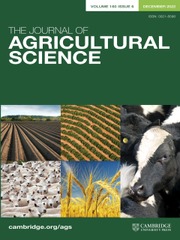Article contents
Nutrition in relation to reproduction in sows
Published online by Cambridge University Press: 27 March 2009
Extract
Gilts of the ‘Palouse’ breed were divided into two groups; one group was full fed from weaning to 1501b. and the other group was fed 70% of full feeding. After six generations, one-half of the pigs in each group were shifted to the other plane of nutrition, thus forming four groups: high-high (HH), low-high (LH), low-low (LL) and high-low (HL). F10 gilts were slaughtered 38 or 100 days post-coitum to study reproductive and prenatal phenomena.
1. Ten successive generations of controlled feeding had no significant effect on: length of Fallopian tubes, weight of corpus luteum, percentage of implantation, number of viable foetuses, foetus weight, weight of placental membranes, volume of placental fluids or embryonic mortality.
2. There were significant differences between the high and low planes of nutrition in: weight of pituitary, thyroid and adrenals, weaning weight, puberty weight, puberty weight to birth weight, puberty weight to weaning weight and puberty age. The effect of six generations of controlled feeding was not maintained when the plane of nutrition was changed from high to low or low to high.
3. The frequency of silent heat and the number of services per conception was lower in the low planes than in the high planes.
4. Ova migration occurred in both directions in 41% of the gilts; one to four ova migrated. The foetal sex ratio ranged from 4:0 to 1:7 with an average of 1:1. The sexes were unevenly distributed in the horns.
5. Foetus weight at 38 or 100 days post-coitum was not affected by plane of nutrition or sequence in the uterine horn.
6. Within-litter variations were highest in the volume of allantoic fluid followed in order by variations in weight of placental membranes and then the amniotic fluid and foetus.
7. Foetal mortality was not related to sequence in the uterine horn or the number of implantations.
8. There seemed to be two peaks of early prenatal mortality, one at implantation and another at the onset of organo-genesis.
Information
- Type
- Research Article
- Information
- Copyright
- Copyright © Cambridge University Press 1960
References
REFERENCES
- 6
- Cited by

